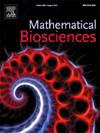Stability of periodic solution for a free boundary problem modeling small plaques
IF 1.8
4区 数学
Q2 BIOLOGY
引用次数: 0
Abstract
Mathematical models describing the growth of plaque in the arteries (e.g., Friedman and Hao (2015), Friedman et al. (2015), Hao and Friedman (2014), McKay et al. (2005) and Mukherjee et al. (2019)) were introduced. All of these models include the interaction of the “bad” cholesterols, low-density lipoprotein (LDL), and the “good” cholesterols, high-density lipoprotein (HDL), in triggering whether plaque will grow or shrink.
Because the blood vessels tend to be circular, 2D cross-section model is a good approximation, and the 2D models are studied in Friedman et al. (2015), Zhang et al. (2023) and Zhao and Hu (2022). A bifurcation into a 3D plaque was recently studied in Huang and Hu (2022). All of these models assume a constant supply of LDL and HDL from the blood vessel.
In reality, nutrient concentration changes with the intake of food, which happens very often in a periodic manner. When the LDL and HDL supplies from the blood vessel are periodic and are not too far away from the prevalent values, a periodic solution was obtained in Huang and Hu (2023). In this paper, we carry out the linear stability analysis of this periodic solution and provide simulation results to confirm our analysis.
以小斑块为模型的自由边界问题周期解的稳定性
介绍了描述动脉斑块生长的数学模型(例如Friedman and Hao(2015)、Friedman et al.(2015)、Hao and Friedman(2014)、McKay et al.(2005)和Mukherjee et al.(2019))。所有这些模型都包括“坏”胆固醇,低密度脂蛋白(LDL)和“好”胆固醇,高密度脂蛋白(HDL)的相互作用,以触发斑块的生长或缩小。由于血管趋向圆形,二维截面模型是一个很好的近似,Friedman et al.(2015)、Zhang et al.(2023)和Zhao and Hu(2022)对二维模型进行了研究。最近,Huang和Hu(2022)研究了3D斑块的分叉。所有这些模型都假定从血管中源源不断地供应LDL和HDL。实际上,营养物质的浓度随着食物的摄入而变化,这种变化经常以周期性的方式发生。当来自血管的LDL和HDL供应是周期性的,并且离流行值不远时,Huang和Hu(2023)获得了一个周期性的解决方案。本文对该周期解进行了线性稳定性分析,并给出了仿真结果来验证我们的分析。
本文章由计算机程序翻译,如有差异,请以英文原文为准。
求助全文
约1分钟内获得全文
求助全文
来源期刊

Mathematical Biosciences
生物-生物学
CiteScore
7.50
自引率
2.30%
发文量
67
审稿时长
18 days
期刊介绍:
Mathematical Biosciences publishes work providing new concepts or new understanding of biological systems using mathematical models, or methodological articles likely to find application to multiple biological systems. Papers are expected to present a major research finding of broad significance for the biological sciences, or mathematical biology. Mathematical Biosciences welcomes original research articles, letters, reviews and perspectives.
 求助内容:
求助内容: 应助结果提醒方式:
应助结果提醒方式:


